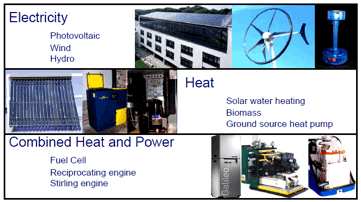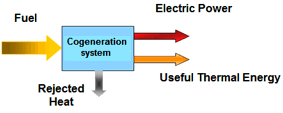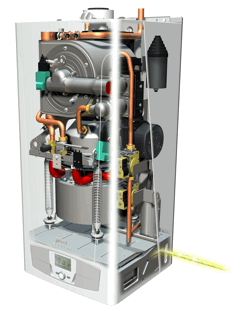

 HOME | ÍNDICE POR TÍTULO | NORMAS PUBLICACIÓN
HOME | ÍNDICE POR TÍTULO | NORMAS PUBLICACIÓN Espacios. Vol. 36 (Nº 07) Año 2015. Pág. 13
José de SOUZA 1; Leandro PELEGRINI 1; Sérgio Deitos BITTENCOURT 1; Paulo MARIOT 1, Franciele WESCHENFELDER 1; Lirio SCHAEFFER 1
Recibido: 30/11/14 • Aprobado: 01/02/15
2. Renewable microgeneration technologies
4. Cogeneration technologies for residential applications
ABSTRACT: |
RESUMO: |
In developing countries, biomass accounts for approximately 35% or higher of the primary energy supply. The ever-increasing global energy demand requires a further increase in biomass energy utilization for distributed electricity generation and domestic heating in both developing and developed countries. Biomass-fuelled CHP systems or micro-CHP can efficiently convert biomass chemical energy into electricity and heat. Biomass energy has its advantage of continuity over the intermittence of solar energy and wind energy. Biomass CHP systems have received a great deal of attention over the past decade. [1]
The concept of combined heat and power (CHP) or cogeneration has been known for a long time. Because of the growing environmental awareness, it receives again more attention. A large amount of energy in the world is used for building heating. Most buildings in Western Europe are heated with a central heating system using natural gas or a fuel oil fired furnace. A next step could be to replace these furnaces by a CHP unit, not only providing heat to the building, but also electrical power. At the moment, new technologies are emerging on the market, having a promising prospect for the near future, providing CHP for small buildings, as houses and small apartments. [2]
The introduction of distributed, decentralized energy production systems could contribute considerably to diversify and secure energy supply, to increase system-scale efficiency and the presumed reduction in various polluting gas emissions. Micro-CHP is now in its demonstration phase in a number of countries, on the brink of commercial market entry. [3] Micro-CHP comprehends all systems less than 35kW of electrical production. These systems range from single family homes to small office buildings. In a typical micro-CHP system, electricity is generated on-site from the combustion of a fuel source in an electrical generation set. Three major obstacles currently existing to market penetration are cost, the requirement for market transformation, and developing the necessary maintenance skill base. [4]
Figure 1 below presents the three main groups of microgeneration technologies from renewable sources, especially for combined heat and power which is discussed on this article.

Figure 1 – Microgeneration technologies. [10]
The use of micro-CHP systems has many advantages as well as disadvantages. Micro-CHP systems increase efficiency of fuel. Approximately 85% of the energy put into a system is used for either electrical power or heating and cooling purposes. One major disadvantage of micro-CHP systems is the high initial costs of the equipment that make up the systems. Another advantage that micro-CHP systems have over traditional central power plants is the difference in energy costs. [4]
It is the simultaneous production in a sequential way of two forms of energy from one fuel as shown in the diagram of Figure 2. The most common process is the production of electricity and thermal energy (heat or cold) from the use of fuels such as natural gas, biomass, diesel fuel, among others. Cogeneration is worldwide considered as the main option for a considerable energy saving. In European countries has also seen a growth in the potential use of these systems in the residential sector, as in Asian countries in the fields of industry and commerce. There is great availability of cogeneration systems and equipment suitable for residential and commercial applications. [5]

Figure 2 – Cogeneration system diagram. [5]
Cogeneration technologies for residential, commercial and institutional applications can be classified according to their prime mover and from where their energy source is derived. Apart from reciprocating engine and micro-turbine based cogeneration systems for residential, commercial and institutional applications, technologies most likely to be successful long term are fuel cell based cogeneration systems and Stirling engine cogeneration systems because of their potential to achieve high efficiency and low emission levels how it is shown on table 1. [6], [16]
Table 1 – Different technologies related to the power and/or heat generation. [16]

An important determinant of the effectiveness of micro-CHP is the carbon intensity of the national electricity supply. Micro-CHP appliances consume more fuel than condensing boilers; the benefit from micro-CHP comes from the electricity generated. It is essential that the units are sized correctly and installed in the optimum location, with the correct control system. [7]
Small-scale biomass-fired CHP system is ideal for use on farms and in other large domestic buildings as a decentralized energy strategy. However, it requires a strong logistical chain for distributing the biomass (pellets, chips, briquettes). If so, most CHP systems on the market are even powered using fossil fuels, usually gas and oil, which does not sit well with the institutes sustainable energy ambitions. [8]
There are five main categories of micro-CHP as shown following. With the exception of fuel cells, all of them use an engine to drive a generator and thus produce electricity.
4.1 Stirling engine based systems
Stirling engines are external combustion engines used in a much smaller proportion of micro-CHP units. They are currently being launched into the domestic market as a replacement for gas boilers. It can runs on oil, gas or even solid fuel (biomass), although only gas is currently approaching a mass market position. [7] There are some benefits respecting IC engine: continuous external combustion, high thermodynamic efficiency, noise reduction, long maintenance interval. [12].
Stirling engines have a higher heat to power generating ratio than fuel cells, and are therefore more applicable to larger dwellings with higher heat loads in order to concurrently satisfy electricity demand. Fuel cells, on the other hand, are currently more suited to smaller dwellings with lower than average heating demands. [14]
This technology is not fully developed yet, and it is not widely used; however, it has good potential because of its ability to attain high efficiency, fuel flexibility, low emissions and good performance at partial load. Unlike reciprocating internal combustion engines, the heat supply is from external sources, allowing the use of a wide range of energy sources including renewable energy sources like solar or biomass. Stirling engines have low wear and are quieter and smoother than reciprocating internal combustion engines. [6], [15]
These systems are largely employed in many applications such as schools, hotels, hospitals and industrial buildings. However, for domestic use the availability of suitable internal combustion engine is very low due to noise and vibration generating. [14], [12] Reciprocating internal combustion engines are suitable for small-scale cogeneration applications because of their robust and well-proven technology. Even so, they do need regular maintenance and servicing to ensure availability. They are available over a wide range of sizes ranging from tens of kilowatts to more than 10 MW, and can be fired on a broad variety of fuels with excellent availability, making them suitable for numerous cogeneration applications. [6]
An internal combustion (IC) engine burns the fuel (controlled explosion) directly inside the engine cylinder or vessel, producing heat and gas emissions as a by-product. A typical example of this type of technology is your condensed boiler. The disadvantage of this technology is that it emits more pollutants and has shorter service lead times. [15]
Some Organic Rankine Cycle (ORC) engines are quite small and light, with theoretical net electrical efficiencies of up to 17%. Some units can also vary their output in response to the heating demand [17].
Micro-turbine systems are scaled down versions of combustion turbines that provide reasonable electrical efficiency of about 30%, multi-fuel capability, low emission levels, and heat recovery potential, and need minimal maintenance. For cogeneration applications, an overall efficiency of 80% and above can be achieved. Research is ongoing for systems with capacities less than 25 kW, e.g. 1 and 10 kW, which will be suitable for the single-family residential buildings. Micro-turbines offer a number of advantages when compared to reciprocating internal combustion based cogeneration systems. These include compact size, low weight, small number of moving parts and lower noise. In addition, micro-turbine based cogeneration systems have high-grade waste heat, low maintenance requirements and low vibration. However, in the lower power ranges, reciprocating internal combustion engines have higher efficiency. Besides the use of natural gas, other fuels like diesel, landfill gas, ethanol, industrial off-gases and other bio-based liquids and gases can be used. [6]
Fuel cell micro-CHP also known as a home fuel cell is still very much a technology in the early stages of development and perhaps many years away from being commercially available worldwide. Fuel cells convert hydrogen and oxygen directly into electricity via an electrochemical process. It offers very low emissions, a high efficiency and very low noise levels. In the process, the heat is produced as a by-product of the electrochemical process and water is also produced as the waste product. A lot of funding and research is currently going into this process and it is estimated that in around ten years‟ time it will be able to compete on a commercial scale. [13]
Fuel cells generate power significantly more efficiently than ICs and the FPSEs. For example an engine based boiler has a heat to power ratio of 1.5:1 whereas a fuel cell CHP boiler has a 1:1 ratio. This is because fuel cell CHPs convert chemical energy directly to an electrical current, maximizing the efficiency [15]. Fuel cells are promising in the micro-CHP field due to their potential for high electricity output. Current fuel cell designs are complex and require careful control at start-up. Current prototypes also tend to be large, but future models are expected to be smaller. [7]
Micro-CHP is seen as a potential replacement for standard domestic gas boiler installations. Baxi Ecogen micro-CHP is the first widely available wall-hung domestic micro-CHP boiler in the UK. Baxi Ecogen is a type of Stirling engine micro-CHP unit. This type of engine is where the current technology is being concentrated. [13]
The global sales of micro-CHP units are still at a nascent stage of the power generation landscape. Currently, Japan is the leader, with Honda's ECOWILL® and Yanmar's Genelight® units accounting for the majority of the sales. The German market contributes to just under one-fifth of the global sales, with SenerTec and Power Plus Technologies being the primary companies operating in this country [7]. The Baxi Ecogen®, which is illustrated below, is one of the first generation FPSE (Free Piston Stirling Engine) CHPs available in the market. [15]

Figure 3. The UK's Baxi Ecogen® domestic CHP boiler: heat and power generating. [7]
By combining the cogeneration system (engine, electric generator and heat recovery system) to an absorption refrigerator that uses the waste heat, three-generation system is achieved, able to produce electricity, heating and cooling (for air-conditioning) at the same time. In this way, to the advantages of the combined production of heat and electricity you can add production of cold, with a self-evident increase in energy saving. So that cogeneration produces the most energy saving, it is essential that the heating and/or cold produced be used almost entirely by the users, and that the surplus electricity be sold to the national grid at convenient prices. [9]
Also, there is a hybrid energy model that consists of the following four principle parts: a cogeneration process, which employs a sustainable propulsion system; a thermal process; a photovoltaic solar process; and an electrical process, which implements an environment friendly system aimed at reducing energy demands, costs and emissions. [11]
The importance of using biomass as an energy source is essential for energy production. The most important way of increase energy production efficiently is using micro-turbines. For example, using this technology, overall efficiency of 80% can be achieved.
The concept of combined heat and power (CHP) or cogeneration can be applied in many cases of biomass conversion. The micro-CHP system presents advantages over other resources. It offers a better use of energy. Systems and cogeneration applications technologies are promising in the area of renewable energy. By smaller amount of energy generated at different points in the maximization of income is very important.
Maximizing the use of energy is a smart way to expend energy. There are already commercial alternatives that can be applied in the generation of renewable energy. So, it must be bring to Brazil, to develop this technology due to the massive quantity of biomass available.
1. QIU, Guoquan et. Al. Experimental investigation of a biomass-fired ORC-based micro-CHP for domestic applications. Fuel 2012; 96: 374–382.
2. DE PAEPE, M. et al.. Micro-CHP systems for residential applications. Energy Conversion and Management. 2006; 47: 3435–3446.
3. FABER, Albert. Exploring domestic micro-cogeneration in the Netherlands: An agent-based demand model for technology diffusion. Energy Policy. 2010; 38: 2763–2775.
4. MORAN, A., MAGO P. J.; CHAMRA L. M. Thermoeconomic modeling of micro-CHP (micro-cooling, heating, and power) for small commercial applications. Int. J. Energy Res. 2008; 32: 808–823.
5. Ramos, Eduardo Ferreira. Análise do desempenho de um sistema de cogeração com uma microturbina a gás natural. Dissertação de mestrado. PUC-Rio. 2007. 174 pg.
6. ONOVWIONA H.I.; UGURSAL, V.I. Residential cogeneration systems: review of the current technology. Renewable and Sustainable Energy Reviews 2006; 10: 389–431.
7. COSPP. http://www.cospp.com/articles/print/volume-10/issue-3/ features/micro-chp-comes-to-north-america-devices-include-gas-fired-generat ors-from-honda.html. Accessed on july 6, 2012.
8. Biopact. News. http://news.mongabay.com/bioenergy/2006/11/engineers-developing-biomass -fired.html. Accessed on July 6, 2012.
9. ENFORCE. Practical Guide on Energy Saving and Efficiency in Buildings. http://www.enforce-een.eu/wp/eng/wp-content/uploads/2012/02/ENFORCE-practical-guide-English-.pdf. Accessed on July 7, 2012.
10. Potential for Microgeneration: Study and Analysis. www.berr.gov.uk/ files/file27558.pdf. Accessed on 18 July 24, 2012.
11. GALVÃO, J. R. et. al. Cogeneration supply by bio-energy for a sustainable hotel building management system. Fuel Processing Technology 2011; 92: 284–289.
12. D'ACCADIA, M. Dentice et al. Micro-combined heat and power in residential and light commercial applications. Applied Thermal Engineering 2003; 23: 1247–1259.
13. WYSE, B. Investigation into the Time-Shifting Of Domestic Heat Loads. Department of Mechanical Engineering. Thesis. University of Strathclyde, 2011.
14. ALLEN, S. R. Prospects for and barriers to domestic micro-generation: A United Kingdom perspective. Applied Energy. 2008; 85: 528–544.
15. CHP Boilers. www.thegreenage.co.uk/ghome/chp-boilers. Acessed on July 20, 2012.
16. Brenda Boardman et. Al. 40% House. http://www.eci.ox.ac.uk/research/ energy/downloads 40house/40house.pdf. Accessed on July 17, 2012.
17. Commercial micro-CHP Field Trial Report. http://www.seai.ie/Publications/ Your_Business_Publications/Commercial_micro-CHP_Field_Trial_Report.pdf. Accessed on July 17, 2012.
1 Laboratório de Transformação Mecânica – LdTM – Centro de Tecnologia, Universidade Federal do Rio Grande do Sul – RS – Brasil